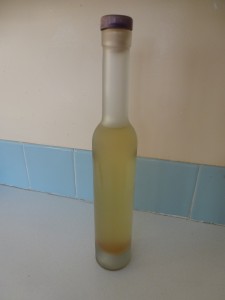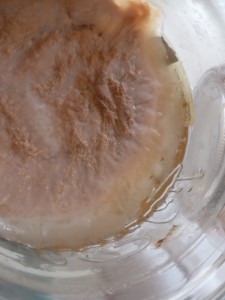The best laid schemes o’ mice an’ men
Gang aft a-gley.
-Robert Burns, “To a Mouse”
 This year, for the first time, I successfully “made” vinegar. I didn’t write about it earlier because I didn’t feel like I had actually done anything, or learned anything. Hence the quotation marks. The truth is that with the numerous little crocks and tubs in which I’ve fermented cider, every so often something really weird happens that I can’t explain.
This year, for the first time, I successfully “made” vinegar. I didn’t write about it earlier because I didn’t feel like I had actually done anything, or learned anything. Hence the quotation marks. The truth is that with the numerous little crocks and tubs in which I’ve fermented cider, every so often something really weird happens that I can’t explain.
I tried really hard to make vinegar last year. I read quite a bit online about the process. The conversion of alcoholic beverages like wine and cider into vinegar is a fermentation in the broad biochemical sense. When we make cider, yeast, a fungus, digests the sugar in apple juice, and produces alcohol. In the case of vinegar, the creature doing the digesting is acetobacter, the food is alcohol, and the byproduct acetic acid.
Something very interesting happens once acetobacter takes hold of a crock of booze. The bacteria need oxygen, so they weave a little raft of cellulose that floats on the surface of the liquid. This raft appears as a snotty layer of scum. In direct contrast to its appearance, it’s been given a rather quaint name: “mother of vinegar.”
Vinegar-makers working with commercial alcohol will generally inoculate the drink with a bit of mother. However, when working with fresh, unpasteurized cider, the vinegar process will happen of its own accord, though let me tell you that it happens very unpredictably.
Last fall I left a crock of dry cider exposed to the air in the back reaches of my basement, and waited. Soon a powdery-looking foam developed on the surface. There was clearly some kind of process taking place. An exothermic process, to be more precise: if you held your hand a few inches above the foam you could feel heat emanating from the liquid. I tasted the cider every few weeks. It changed, but never became sour. It actually seemed to be losing acidity. One day in the spring I tasted it, and in a weird inversion of the wedding at Cana, the delicious, alcoholic cider had been transformed to water. It had no taste, and no acidity. I almost wept.

I’ve only been making cider for two years, but I’ve already seen that any number of microbes can get a stranglehold on your fermentation tubs, and they all throw up different types of gross-looking scum. This year I saw some very bizarre blobs indeed. Most often they look like white dust floating on the surface, perhaps with delicate veins running throughout, like marble. One time a peculiar, fine honeycomb structure developed on the surface of the cider. Sometimes boogers form. Several times the flotsam looked like beer trub. Sometimes it’s snow white. Others it’s puke green, or chestnut brown with hints of amber. Most often it’s beige.
Sometimes these alien landscapes appeared on dry cider that I intentionally left exposed to the air. Once they appeared on dry cider that was in a glass jug fitted with an air-lock. A couple times they showed up part way through the initial alcoholic fermentation. I should mention that if you’re trying to make cider and scum like this forms, you can usually just rack the cider and leave the sludge behind, and fermentation will continue. This year I was very curious to see what happened, so I left most of them alone.
By mid fall I had a little closet with five or six one gallon jugs, all covered in some kind of bacterial culture. Throughout the fall, every couple of weeks I taste all of them, using a syringe to poke through the scum and extract a few drops of liquid. Some still tasted like cider, a few others like diluted cider. Two of them hit my tongue and had a startling, sour-apple acidity. I strained off the liquid and bottled it as vinegar. I also transferred what I can only hope is a mother of vinegar to some dry cider from the cellar.
The vinegar looks, smells, and tastes absolutely nothing like Heinz cider vinegar. Mine is the colour of creamed honey. It’s very hazy, though as it sits in the pantry I notice that there is sediment accumulating on the bottom, so perhaps it will clear with time. It smells and tastes unmistakably of fresh apples, with a very full, well-rounded acidity.
If the tub of dry cider that I inoculated turns out well, I’ll have at least two gallons of vinegar to play with, and it will no doubt end up in all my pickles and dressings. For now I’m content to consume it by diluting it slightly and pouring it over charcuterie and bread.